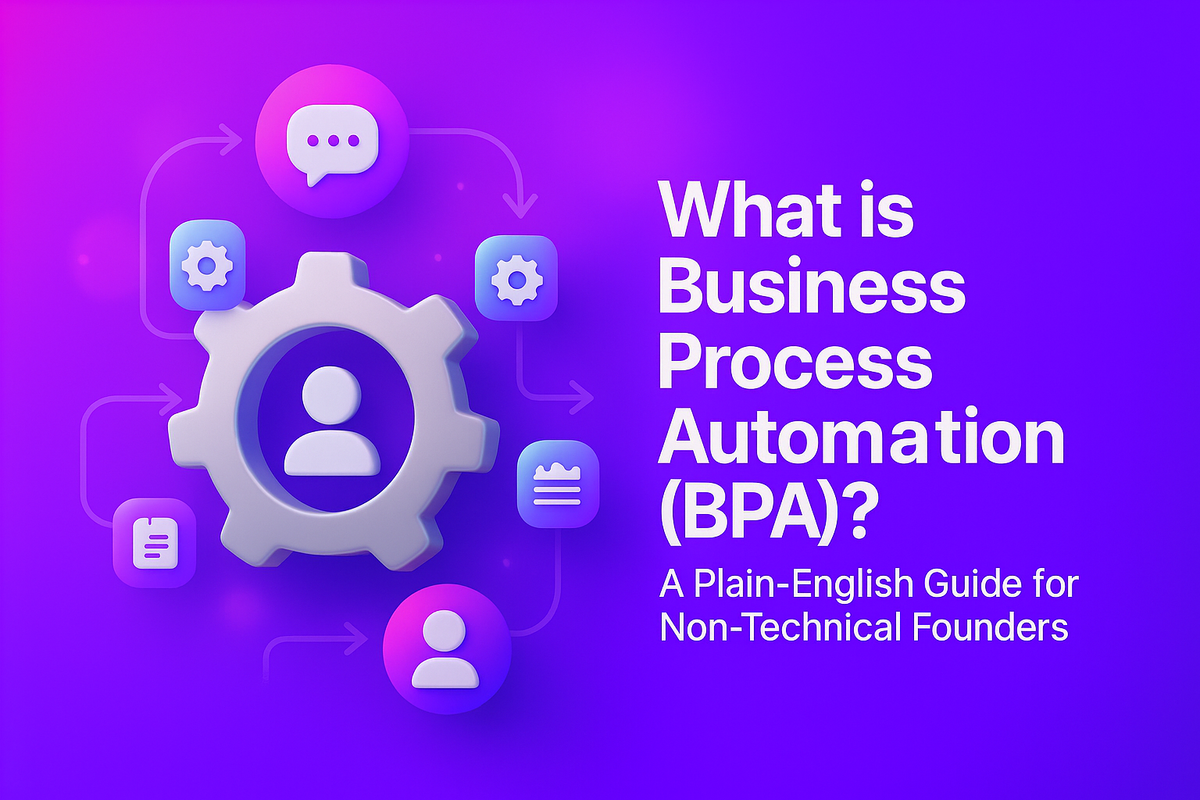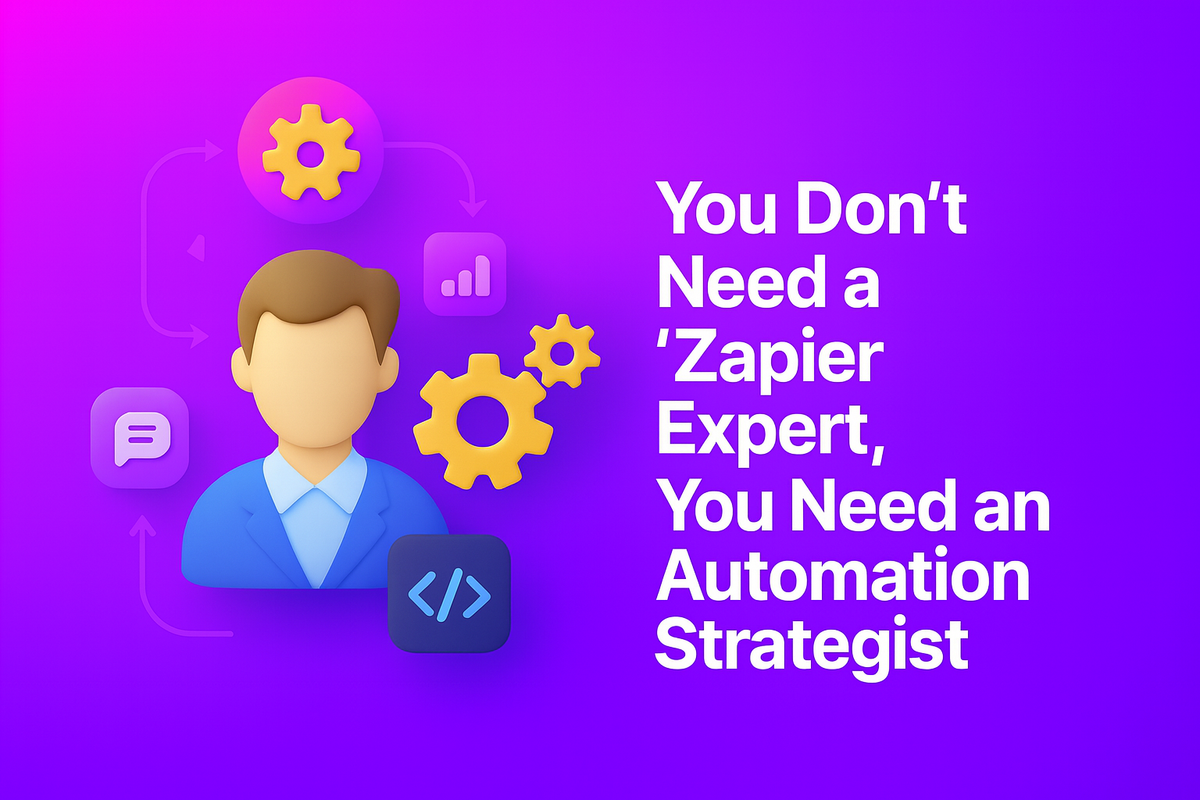
As a small business owner in the Netherlands, you are the chief strategist, the head of sales, the finance manager, and often, the lead problem-solver. You are constantly juggling priorities, battling administrative tasks, and looking for a competitive edge. You hear the term "Artificial Intelligence" or "AI" everywhere—on the news, in business journals, from tech giants. It often sounds like a futuristic concept reserved for massive corporations with huge R&D budgets, not for a growing SME like yours.
What if that assumption was wrong?
The reality is that AI has moved beyond the realm of science fiction and into the world of practical business tools. AI Automation is no longer a luxury; it is becoming an accessible and powerful engine for growth, efficiency, and innovation for small businesses. It's about more than just speeding up tasks; it's about making your business smarter, more responsive, and more resilient.
What is AI Automation, Really?
In simple terms, think of AI Automation as giving your software the ability to perform tasks that traditionally required human intelligence—tasks involving judgment, understanding, and learning.
This guide will demystify AI Automation. We will break down what it is, how it differs from the automation you might already know, explore real-world examples of how it's transforming small businesses today, and provide a clear roadmap for how you can get started.
From Following Rules to Making Decisions: The AI Leap
You might already be using some form of automation. Perhaps you use a tool that automatically sends a thank-you email when someone fills out a form on your website. This is traditional, rule-based automation. It's incredibly useful, but it works like a simple calculator: it follows a very strict, pre-programmed set of "if this, then that" instructions. It cannot handle ambiguity or deviation from its rules.
AI Automation is the next evolution. It's the difference between a calculator and a seasoned financial analyst. While the calculator can execute commands perfectly, the analyst can interpret an entire spreadsheet, spot trends, understand context, and make an informed recommendation.
AI-powered systems can "read" an email from an unhappy customer, understand the sentiment is negative, and automatically flag it for urgent human attention. They can "look" at thousands of sales data points and predict which products will be most popular next month. They can learn from past results to improve their performance over time.
Key Differences at a Glance
| Feature | Traditional Automation (Rule-Based) | AI Automation (Intelligent) |
|---|---|---|
| Task Type | Highly repetitive, predictable tasks with clear rules. | Complex tasks requiring judgment, interpretation, or prediction. |
| Data Handling | Requires structured data (e.g., fields in a form, cells in a spreadsheet). | Can understand and process unstructured data (e.g., text from emails, PDFs, images). |
| Decision Making | Strict "If This, Then That" logic. It cannot handle exceptions. | Uses pattern recognition and predictive models. It can manage ambiguity and make informed "best guess" decisions. |
| Learning Ability | Static. It performs the same way every time unless a human reprograms it. | Dynamic. It can learn from new data and feedback to improve its accuracy and effectiveness over time. |
In essence, traditional automation handles the doing. AI automation handles the thinking and learning.
Practical AI in Action: 4 Areas to Transform Your SME
The theory is interesting, but the real value is in the application. Where can AI Automation make a tangible, measurable difference in your day-to-day operations? Let's look at four key areas.
1. Supercharging Your Customer Service
The Common Problem
Your team spends hours answering the same basic questions via email or phone ("What are your opening hours?", "What is your return policy?"). Response times lag during busy periods, and offering support outside of business hours is a major challenge and expense.
The AI Automation Solution
Intelligent Chatbots: Modern AI chatbots are worlds away from the frustrating, rigid bots of the past. They use Natural Language Processing (NLP) to understand what customers are asking in their own words. They can instantly answer a vast range of common questions 24/7, access order information, and guide users to the right resources on your website.
Smart Ticket Routing: AI can analyze the content of incoming support emails. It understands if the customer is angry or happy (sentiment analysis) and what the email is about (e.g., a billing query, a technical problem). It then automatically routes the ticket to the right person or department and prioritizes urgent issues, ensuring the most critical problems are addressed first.
The Tangible Benefits
- 24/7 Availability: Provide instant answers to your customers, anytime, day or night.
- Increased Team Productivity: Free up your human support agents from repetitive queries to focus on complex, high-value customer issues that require empathy and creative problem-solving.
- Improved Customer Satisfaction: Faster response times and instant answers lead to happier, more loyal customers.
2. Making Your Marketing Smarter, Not Harder
The Common Problem
You're sending generic email newsletters to your entire list, hoping something sticks. You're spending money on digital ads but are unsure which headlines or images are truly effective. Personalizing your marketing feels like an impossible task without a dedicated team.
The AI Automation Solution
AI Content Generation: Tools like Jasper, Copy.ai, or even the advanced features in HubSpot can help you overcome writer's block. They can generate multiple versions of ad copy, draft blog post outlines, write product descriptions, and craft compelling social media posts, all based on a simple prompt. Your team then edits and refines, saving hours of creative effort.
Predictive Analytics: Many modern CRM platforms use AI to analyze customer behavior. They can predict which leads are most likely to convert, allowing your sales team to focus their energy where it matters most. AI can also identify customers at risk of churning, enabling you to proactively reach out to retain them.
The Tangible Benefits
- Higher Conversion Rates: Deliver more relevant, personalized messages that resonate with different customer segments.
- Better Marketing ROI: Optimize your ad spend by letting AI figure out the best-performing combinations of copy and creative.
- Increased Content Output: Create more high-quality marketing content in a fraction of the time.
3. Streamlining Your Finance and Administration
The Common Problem
A team member (or maybe even you) spends countless hours manually typing data from PDF invoices into your accounting software (like Exact Online or AFAS). This work is tedious, slow, and prone to costly human errors. Managing receipts and expense reports is a constant headache.
The AI Automation Solution
Intelligent Document Processing (IDP): This is one of the most powerful and accessible forms of AI for SMEs. IDP software uses AI-powered Optical Character Recognition (OCR) and machine learning to "read" and "understand" documents just like a human. You can automatically forward supplier invoices to the system, and it will extract the key information—supplier name, invoice number, date, line items, and total amount—and enter it directly into your accounting software, often flagging it for a final one-click approval.
The Tangible Benefits
- Drastic Time Savings: Reduce the time spent on manual data entry by up to 90%.
- Increased Accuracy: Eliminate the typos and errors that lead to incorrect payments and messy financial records.
- Faster Financial Closing: With data entered in real-time, you always have an up-to-date view of your company's finances.
- Improved Employee Satisfaction: Free your team from the soul-crushing task of manual data entry to focus on more strategic financial analysis.
4. Optimizing Your Operations & Supply Chain
The Common Problem
You're either overstocking products, which ties up cash, or understocking them and missing out on sales. Planning delivery routes is a manual process that wastes fuel and time.
The AI Automation Solution
Demand Forecasting: AI algorithms can analyze your historical sales data, seasonality, market trends, and even external factors like holidays or weather to predict future customer demand with remarkable accuracy. This allows you to optimize your inventory levels, ensuring you have what you need, when you need it.
Route Optimization: For businesses with a delivery fleet, AI can calculate the most efficient routes in real-time, factoring in traffic, delivery windows, and vehicle capacity.
The Tangible Benefits
- Reduced Costs: Minimize waste from unsold stock and lower your fuel and maintenance expenses.
- Increased Sales: Avoid "stock-outs" of popular items and ensure you can meet customer demand.
- Improved Efficiency: Fulfill more orders and complete more deliveries in less time.
Your First Steps into AI: A Practical Roadmap for SMEs
Getting started with AI doesn't require a massive budget or a data science degree. The key is to be strategic and start small.
1. Identify Your Biggest Bottleneck
Don't try to boil the ocean. Look for the one process in your business that is the most manual, repetitive, time-consuming, and error-prone. For many businesses, this is invoice processing, customer service queries, or lead management. This is your ideal starting point.
2. Explore AI in Tools You Already Use
Many of the SaaS platforms you use every day—from your CRM to your email marketing software to Microsoft 365—are already embedding powerful AI features. Investigate what your current tools are capable of before adding new ones. You might be surprised by the power you already have at your fingertips.
3. Start with a High-ROI Application
Focus on a project that will deliver clear, measurable value. Automating invoice processing (IDP), for example, provides an immediate and easily calculated return on investment in terms of hours saved and errors eliminated.
4. Partner with an Automation Expert
Navigating the landscape of AI tools and platforms can be overwhelming. A specialist partner can help you cut through the noise. They can work with you to audit your processes, identify the highest-impact automation opportunity for your specific business, and help you select and implement the right technology to ensure a successful outcome.
Conclusion: Your Smartest Employee is Software
AI Automation is no longer a distant concept; it's a present-day reality and a powerful competitive advantage. For small business owners, it's like hiring a team of incredibly efficient, data-driven employees who work 24/7 without ever getting tired.
It's about empowering your human team by taking away the robotic tasks so they can focus on what they do best: building relationships, thinking creatively, and driving the business forward. It's about delighting your customers with instant, intelligent service. And it's about building a more efficient, scalable, and resilient business that is ready for the future.
The Journey Starts Now
The journey into AI starts not with a giant leap, but with a single, strategic step.
Feeling inspired but not sure what that first step should be? We specialize in helping Dutch SMEs demystify AI and implement practical automation solutions. Contact us for a free, no-obligation consultation to discover the #1 AI automation opportunity hiding in your business.


